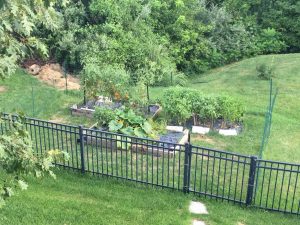what this describes is sealing off the walkways in particular with the plastic. You are still laying out box beds and the plastic stops wicking or growth from the walkways..
once you see it that way it is almost obvious. A healthy natural walkway will reach out and overwelm those beds.
I have seen plenty of raised beds that became problems and no one ever thinks the sod path is the real problem. So start by laying down a plastic sheet to suppress the sod or rototilled land. Open the beds and possibly lay a couple layers of cardboard if it is sod. Protect the plastic on the walk ways somehow.
How We Made a Thriving Garden with Minibeds on Plastic
June 17, 2021
(Psst: The FTC wants me to remind you that this website contains affiliate links. That means if you make a purchase from a link you click on, I might receive a small commission. This does not increase the price you'll pay for that item nor does it decrease the awesomeness of the item. ~ Daisy)
by Rick Marshall
Supply chain issues due to the pandemic reinforced our decision to become more self-reliant and dedicated to garden production. (And less tied to suppliers who are affected by issues that we have no control over.) We slowly changed from casual gardeners interested in making salsa to die-hard gardeners with a desire to produce food for our family.
Our house sits on three-quarters of an acre lot in the Illinois suburbs of St Louis. Most of our land is on a hill. But there is a flat spot at the bottom of our backyard. This is where we have been building our small garden for several years. By no means are we expert gardeners. But we want to share the conversion of our garden over the last few years with all of you.
2017: Our garden was a mess and needed constant weeding
In 2017 we converted our garden from planting rows to a raised bed garden system. But the weeds were horrendous, and we were spending about an hour per week weeding. We tried using plastic inside the raised beds to keep the weeds at a minimum but it didn’t work well for us.
It was challenging to access some of the plants due to the proximity of fencing and the raised beds planted too close together. Plus, the garden was a mess and needed to be reorganized. St Louis has hot and humid summers, and weeds thrive on the weather. Sometimes it was difficult to get motivated to weed the garden in June, July, and August because it was so steamy.
End of 2017: We discover Minibeds on Plastic
At the end of 2017, not long after the final harvest, we came across Herrick Kimball’s Minibeds on Plastic. His system focused on maximizing production and minimizing the weeds. It made sense to us, so we bought his well-written, helpful PDF guide.
Kimball has comprehensive and well-documented Annual Reports on the Minibeds on Plastic system on his website. Herrick’s website contains videos from other people who have used the Minibeds on Plastic system for their own garden. He developed this system for his upstate New York farm. However, the videos show people in Illinois, Wisconsin, and Oklahoma successfully using this system to produce wonderful gardens.
Minibeds on Plastic consists of several 30″ by 30″ small raised beds made of wood. The raised beds are spaced approximately 18″ apart and constructed on top of a plastic mulch barrier. The plastic inside the wood frames is cut out and removed, and used as mini planting beds. Plastic is used over the area surrounding the mini-beds to hold moisture in the soil and prevent weeds from growing.
May 2018: Our garden makeover begins
To get started, we rototilled the entire garden (not everyone does this) and covered everything with the thin plastic we purchased from Farm Plastic Supply. Covering the garden with plastic was the most challenging part of the garden makeover. The plastic is very thin, and any gust of wind lifts it and blows it around. Illinois is known for our wind, so we fought the plastic until we had it anchored to the ground.
We tried to keep our Strawberry plants intact by cutting a hole in the plastic around them and anchoring the plastic around them with the bench. But it ended up not working, and we covered them up with plastic later in the year.
After we laid out the plastic, we used the wooden Minibed frames and landscape edging to hold the plastic down. The Minibed frames are secured to the ground with 2′ lengths of 3/8″ rebar. It works to hold them very steady, and in turn, the wooden Minibeds hold down the plastic film. We used string guides to ensure we had the 18″ spacing correct and in a line to keep the Minibeds organized.
We got a late start planting our garden in 2018
We usually grow most of our plants from seed, but in 2018 we were late. So, we went to the garden center and couldn’t resist buying two huge tomato plants. Those two plants were the first we planted in our newly renovated garden using recycled leftover pieces of our fencing for tomato cages. Along with the tomatoes we added cucumber, watermelon, zucchini, and hot peppers.
In June we added a few more Minibeds and the garden shifted into high gear. The growth we experienced in the first month of our Minibeds on Plastic experiment shocked us. July 15, 2018 we began harvesting our garden. It was an excellent year for our garden. It produced heavily through September and gave us a lot of enjoyment.
The Minibeds on Plastic system changed our garden
Our garden was an overgrown, inconsistent producer with many areas that were hard to access and in constant need of weeding. Minibeds on Plastic changed it into a well-organized system that now produces an abundance of fruit and vegetables and very few weeds. It took a lot of work to get there. But we did most of the hard work in late fall and winter after the final harvest.
Now, our garden produces:
Several types of tomatoes
Tomatillos
Sweet and Hot Peppers
Lettuce
Radishes
Carrots
Garlic: Garlic grows amazingly fast. Did you know the word Chicago comes from a Native American word for garlic?
Zucchini
Butternut Squash
Strawberries
Onions
Pole and Bush Beans
Cucumbers
This past spring, we also added apple trees to our garden, and are looking to add more fruit trees in the coming years. We have always tried to set aside tomato and pepper seeds from the previous year’s harvest to use in the following year’s planting. This year there was a shortage of seeds so were delighted to have the ones we saved from last year. We plan to keep a lot more seeds from many more varieties.
Other benefits of the Minibeds on Plastic system
Gardening should be fun. We enjoy planting and harvesting our garden when it is cool outside. Spending time in the middle of summer weeding our garden when it is hot and humid is not enjoyable! With the Minibeds system, weeding is minimal. It makes gardening much more fun.
Consistent, efficient watering. Custom-fit drip irrigation only waters where we want and doesn’t water unproductive parts of the garden, which helps keep the weeds from growing. And, in this time of drought, the last thing we want is to waste water. Drip irrigation keeps a consistent flow of water to our garden. The tomatoes split less frequently because they are consistently watered—the entire garden benefits from targeted watering.
The many benefits of plastic. We have been using the same black plastic film for the past three years, and it doesn’t show any signs of failure. The plastic slows down evaporation and retains more moisture in the soil. So, the garden needs less frequent watering than before we switched to the Minibeds on Plastic system. (Especially helpful for potential droughts.)
Note: The black plastic keeps the garden warmer during the hot summer months. We recycled some of our landscape rock to cover the black plastic to combat the heat. It keeps the garden cooler and keeps our feet from getting wet when we walk through the garden after the rain.
We continue to experiment with fencing
We live on the very edge of suburbia and have many critters who like to nibble on our garden. Keeping them out has been a challenge. In the past, all it would take is one overnight feeding frenzy, and they would decimate our green beans, lettuce, and peppers.
In 2020, we installed an aluminum 5′ tall fence to deter the deer from eating our garden. (Although they nibble on our apple trees planted outside the garden fence.) Initially we installed a wire mesh fence inside the aluminum fence to keep smaller animals like foxes and rabbits out of the garden. A third layer consisting of a plastic mesh fence was installed in 2021 to keep the smaller rabbits out of the garden.
So far, it seems to be working. We haven’t seen any critters in the garden yet this year.
Want to be more self-sufficient? Grow a garden
Becoming more self-reliant is not something that is accomplished in a single year. It is more similar to a long-distance race. By making small, incremental changes to our system that compound year after year we become more and more self-sufficient. Check out Erica’s book on starting a homestead here for more details.
Covid has taught us that the food supply chain is fragile and can be compromised and interrupted. Gardens are about growing your favorite foods, but these days they are also about providing food security for you and your family.
Gardening is a process, not a one-and-done. Have you tried something different that has improved your garden dramatically? Have you run into any problems that have been difficult to solve? Let’s talk about it in the comments.
About the Author
Rick Marshall lives in the Illinois suburbs of St Louis and founded the Mission Endure Website and Podcast.


No comments:
Post a Comment